E-commerce System Implementation for My Dhabba Restaurant UK
VerifiedAdded on 2023/06/12
|12
|4200
|206
Report
AI Summary
This report addresses the potential of e-commerce in the hospitality sector, specifically focusing on a traditional Indian restaurant named My Dhabba in Coventry, UK. The restaurant, popular but lacking a website, aims to enhance customer service and operational efficiency. The report proposes a database-driven e-commerce system with integrated ERP, utilizing a hybrid cloud architecture for scalability and business continuity. It details the strategy, required changes, implementation plan using an agile methodology, and benefits of the system, including improved customer service, inventory management, and financial tracking. The report also identifies potential risks and provides recommendations for successful implementation, emphasizing change management and continuous improvement. The proposed system includes a cloud-based e-commerce website linked with social media, a point-of-sale system, and integration with mobile restaurant applications, allowing customers to place orders and make payments online.

E-COMMERCE SYSTEM
NAME
DATE
NAME
DATE
Paraphrase This Document
Need a fresh take? Get an instant paraphrase of this document with our AI Paraphraser
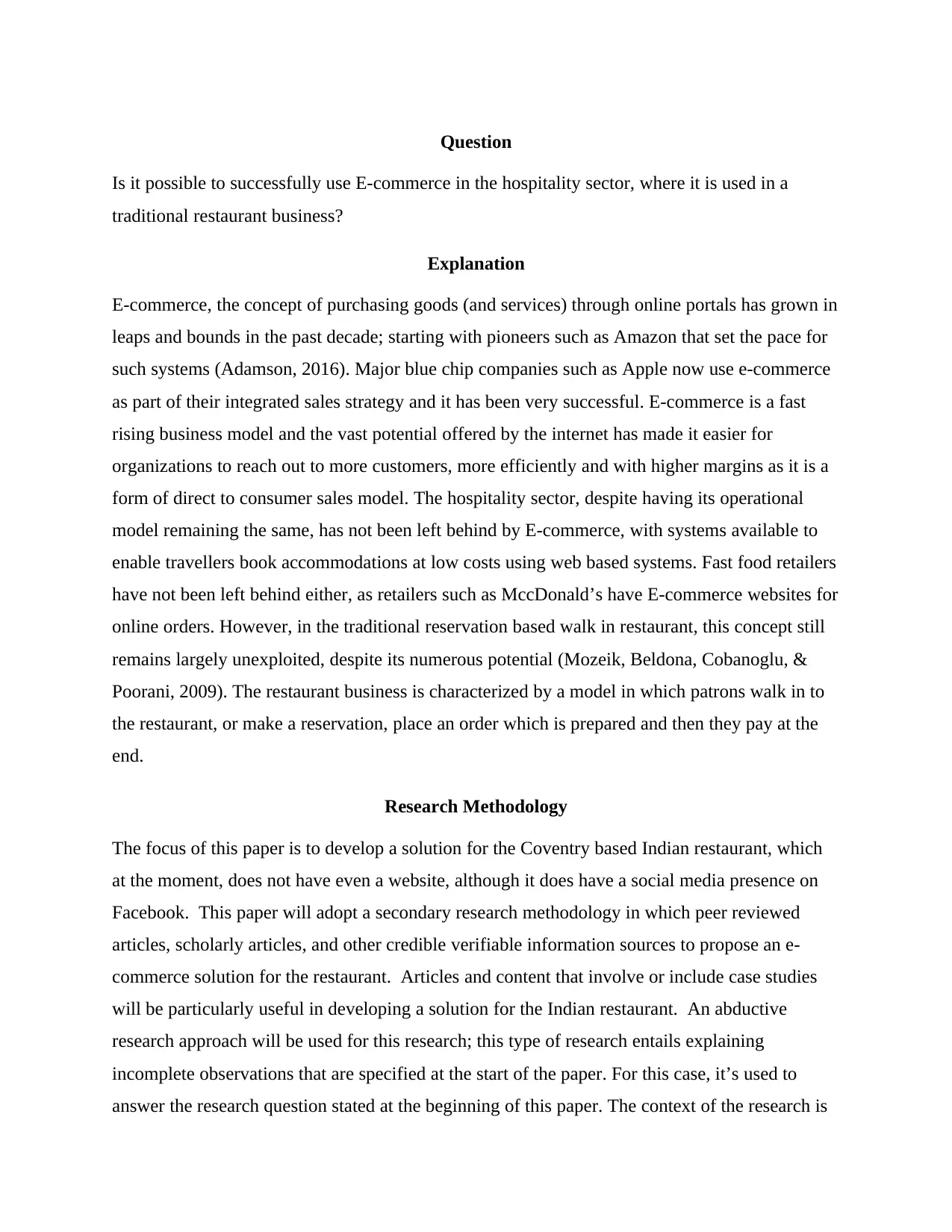
Question
Is it possible to successfully use E-commerce in the hospitality sector, where it is used in a
traditional restaurant business?
Explanation
E-commerce, the concept of purchasing goods (and services) through online portals has grown in
leaps and bounds in the past decade; starting with pioneers such as Amazon that set the pace for
such systems (Adamson, 2016). Major blue chip companies such as Apple now use e-commerce
as part of their integrated sales strategy and it has been very successful. E-commerce is a fast
rising business model and the vast potential offered by the internet has made it easier for
organizations to reach out to more customers, more efficiently and with higher margins as it is a
form of direct to consumer sales model. The hospitality sector, despite having its operational
model remaining the same, has not been left behind by E-commerce, with systems available to
enable travellers book accommodations at low costs using web based systems. Fast food retailers
have not been left behind either, as retailers such as MccDonald’s have E-commerce websites for
online orders. However, in the traditional reservation based walk in restaurant, this concept still
remains largely unexploited, despite its numerous potential (Mozeik, Beldona, Cobanoglu, &
Poorani, 2009). The restaurant business is characterized by a model in which patrons walk in to
the restaurant, or make a reservation, place an order which is prepared and then they pay at the
end.
Research Methodology
The focus of this paper is to develop a solution for the Coventry based Indian restaurant, which
at the moment, does not have even a website, although it does have a social media presence on
Facebook. This paper will adopt a secondary research methodology in which peer reviewed
articles, scholarly articles, and other credible verifiable information sources to propose an e-
commerce solution for the restaurant. Articles and content that involve or include case studies
will be particularly useful in developing a solution for the Indian restaurant. An abductive
research approach will be used for this research; this type of research entails explaining
incomplete observations that are specified at the start of the paper. For this case, it’s used to
answer the research question stated at the beginning of this paper. The context of the research is
Is it possible to successfully use E-commerce in the hospitality sector, where it is used in a
traditional restaurant business?
Explanation
E-commerce, the concept of purchasing goods (and services) through online portals has grown in
leaps and bounds in the past decade; starting with pioneers such as Amazon that set the pace for
such systems (Adamson, 2016). Major blue chip companies such as Apple now use e-commerce
as part of their integrated sales strategy and it has been very successful. E-commerce is a fast
rising business model and the vast potential offered by the internet has made it easier for
organizations to reach out to more customers, more efficiently and with higher margins as it is a
form of direct to consumer sales model. The hospitality sector, despite having its operational
model remaining the same, has not been left behind by E-commerce, with systems available to
enable travellers book accommodations at low costs using web based systems. Fast food retailers
have not been left behind either, as retailers such as MccDonald’s have E-commerce websites for
online orders. However, in the traditional reservation based walk in restaurant, this concept still
remains largely unexploited, despite its numerous potential (Mozeik, Beldona, Cobanoglu, &
Poorani, 2009). The restaurant business is characterized by a model in which patrons walk in to
the restaurant, or make a reservation, place an order which is prepared and then they pay at the
end.
Research Methodology
The focus of this paper is to develop a solution for the Coventry based Indian restaurant, which
at the moment, does not have even a website, although it does have a social media presence on
Facebook. This paper will adopt a secondary research methodology in which peer reviewed
articles, scholarly articles, and other credible verifiable information sources to propose an e-
commerce solution for the restaurant. Articles and content that involve or include case studies
will be particularly useful in developing a solution for the Indian restaurant. An abductive
research approach will be used for this research; this type of research entails explaining
incomplete observations that are specified at the start of the paper. For this case, it’s used to
answer the research question stated at the beginning of this paper. The context of the research is
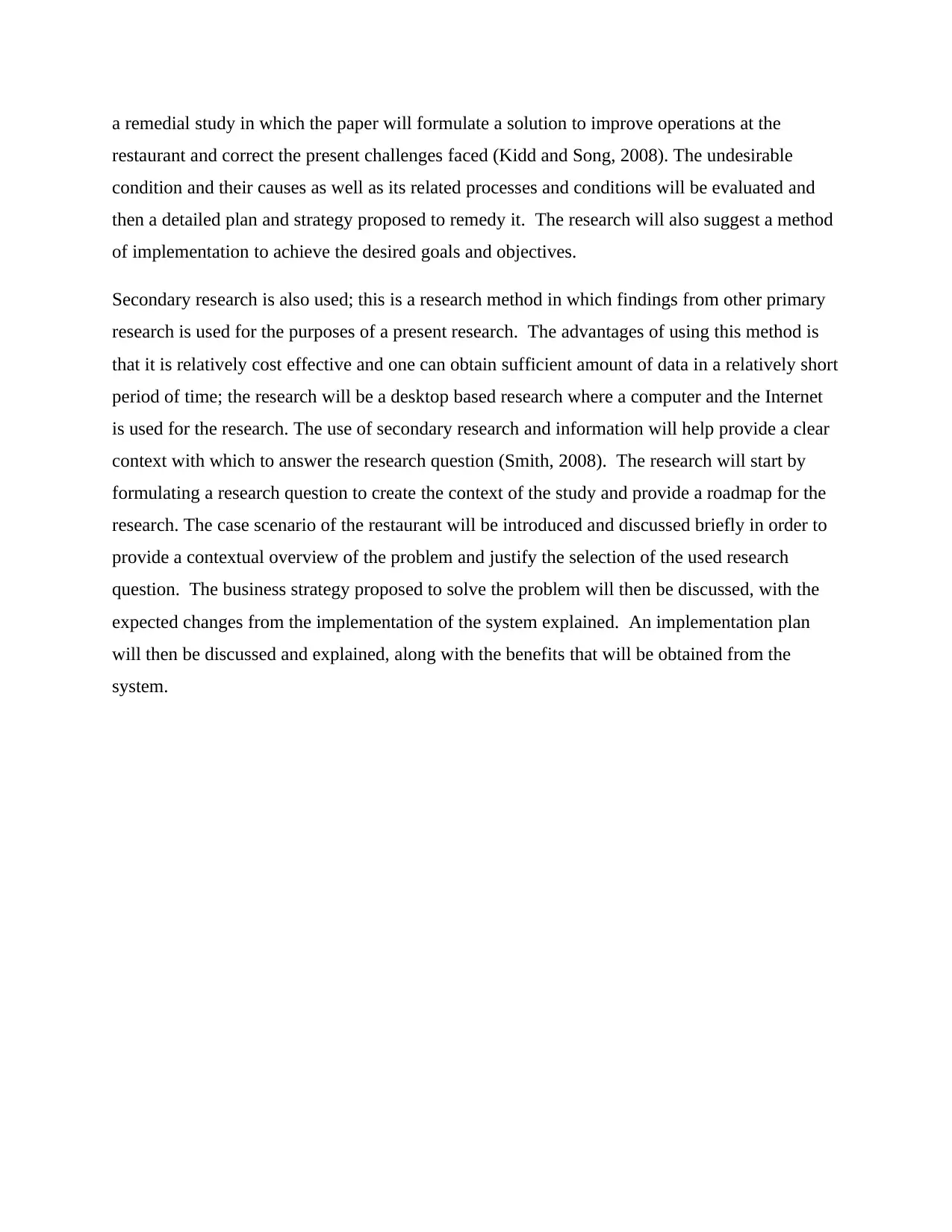
a remedial study in which the paper will formulate a solution to improve operations at the
restaurant and correct the present challenges faced (Kidd and Song, 2008). The undesirable
condition and their causes as well as its related processes and conditions will be evaluated and
then a detailed plan and strategy proposed to remedy it. The research will also suggest a method
of implementation to achieve the desired goals and objectives.
Secondary research is also used; this is a research method in which findings from other primary
research is used for the purposes of a present research. The advantages of using this method is
that it is relatively cost effective and one can obtain sufficient amount of data in a relatively short
period of time; the research will be a desktop based research where a computer and the Internet
is used for the research. The use of secondary research and information will help provide a clear
context with which to answer the research question (Smith, 2008). The research will start by
formulating a research question to create the context of the study and provide a roadmap for the
research. The case scenario of the restaurant will be introduced and discussed briefly in order to
provide a contextual overview of the problem and justify the selection of the used research
question. The business strategy proposed to solve the problem will then be discussed, with the
expected changes from the implementation of the system explained. An implementation plan
will then be discussed and explained, along with the benefits that will be obtained from the
system.
restaurant and correct the present challenges faced (Kidd and Song, 2008). The undesirable
condition and their causes as well as its related processes and conditions will be evaluated and
then a detailed plan and strategy proposed to remedy it. The research will also suggest a method
of implementation to achieve the desired goals and objectives.
Secondary research is also used; this is a research method in which findings from other primary
research is used for the purposes of a present research. The advantages of using this method is
that it is relatively cost effective and one can obtain sufficient amount of data in a relatively short
period of time; the research will be a desktop based research where a computer and the Internet
is used for the research. The use of secondary research and information will help provide a clear
context with which to answer the research question (Smith, 2008). The research will start by
formulating a research question to create the context of the study and provide a roadmap for the
research. The case scenario of the restaurant will be introduced and discussed briefly in order to
provide a contextual overview of the problem and justify the selection of the used research
question. The business strategy proposed to solve the problem will then be discussed, with the
expected changes from the implementation of the system explained. An implementation plan
will then be discussed and explained, along with the benefits that will be obtained from the
system.
⊘ This is a preview!⊘
Do you want full access?
Subscribe today to unlock all pages.

Trusted by 1+ million students worldwide
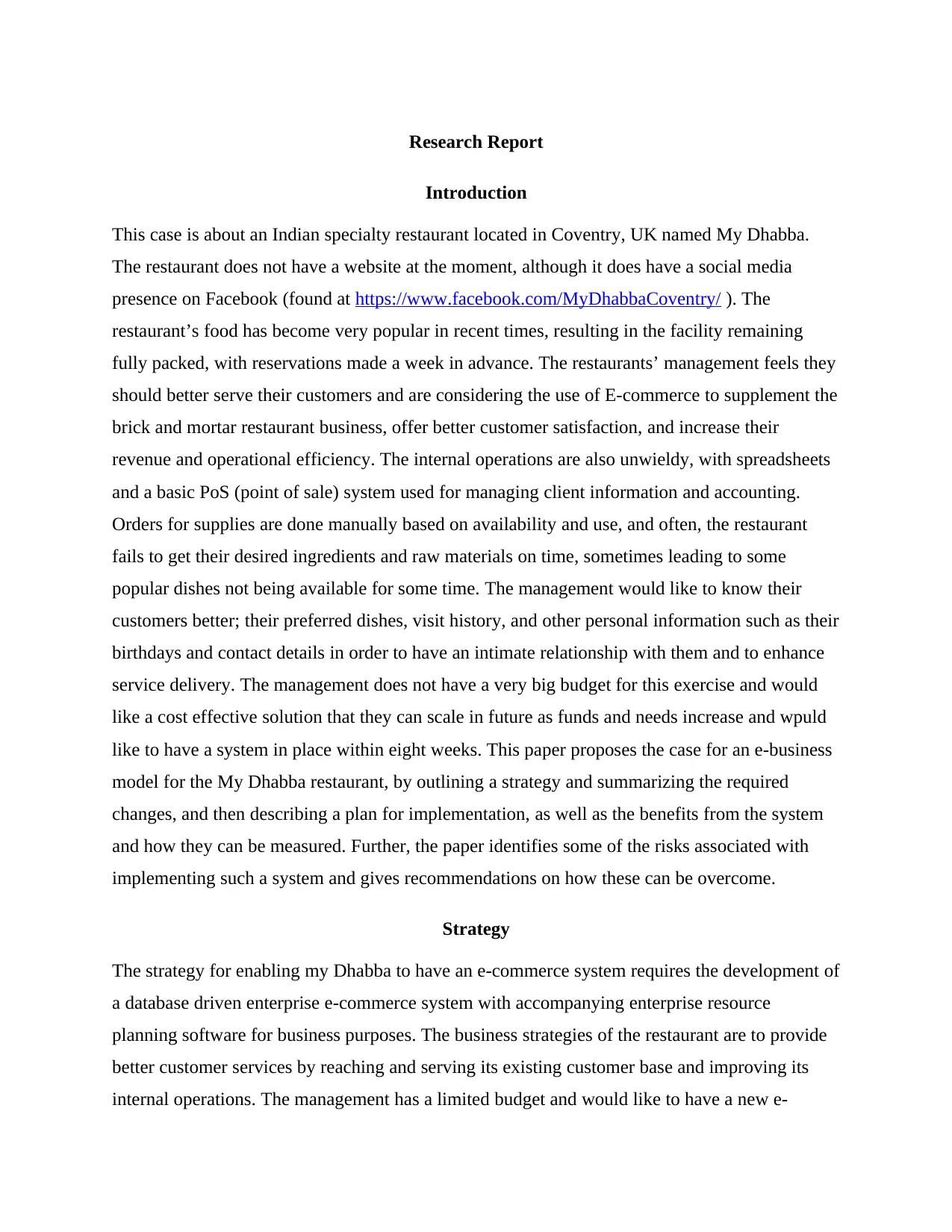
Research Report
Introduction
This case is about an Indian specialty restaurant located in Coventry, UK named My Dhabba.
The restaurant does not have a website at the moment, although it does have a social media
presence on Facebook (found at https://www.facebook.com/MyDhabbaCoventry/ ). The
restaurant’s food has become very popular in recent times, resulting in the facility remaining
fully packed, with reservations made a week in advance. The restaurants’ management feels they
should better serve their customers and are considering the use of E-commerce to supplement the
brick and mortar restaurant business, offer better customer satisfaction, and increase their
revenue and operational efficiency. The internal operations are also unwieldy, with spreadsheets
and a basic PoS (point of sale) system used for managing client information and accounting.
Orders for supplies are done manually based on availability and use, and often, the restaurant
fails to get their desired ingredients and raw materials on time, sometimes leading to some
popular dishes not being available for some time. The management would like to know their
customers better; their preferred dishes, visit history, and other personal information such as their
birthdays and contact details in order to have an intimate relationship with them and to enhance
service delivery. The management does not have a very big budget for this exercise and would
like a cost effective solution that they can scale in future as funds and needs increase and wpuld
like to have a system in place within eight weeks. This paper proposes the case for an e-business
model for the My Dhabba restaurant, by outlining a strategy and summarizing the required
changes, and then describing a plan for implementation, as well as the benefits from the system
and how they can be measured. Further, the paper identifies some of the risks associated with
implementing such a system and gives recommendations on how these can be overcome.
Strategy
The strategy for enabling my Dhabba to have an e-commerce system requires the development of
a database driven enterprise e-commerce system with accompanying enterprise resource
planning software for business purposes. The business strategies of the restaurant are to provide
better customer services by reaching and serving its existing customer base and improving its
internal operations. The management has a limited budget and would like to have a new e-
Introduction
This case is about an Indian specialty restaurant located in Coventry, UK named My Dhabba.
The restaurant does not have a website at the moment, although it does have a social media
presence on Facebook (found at https://www.facebook.com/MyDhabbaCoventry/ ). The
restaurant’s food has become very popular in recent times, resulting in the facility remaining
fully packed, with reservations made a week in advance. The restaurants’ management feels they
should better serve their customers and are considering the use of E-commerce to supplement the
brick and mortar restaurant business, offer better customer satisfaction, and increase their
revenue and operational efficiency. The internal operations are also unwieldy, with spreadsheets
and a basic PoS (point of sale) system used for managing client information and accounting.
Orders for supplies are done manually based on availability and use, and often, the restaurant
fails to get their desired ingredients and raw materials on time, sometimes leading to some
popular dishes not being available for some time. The management would like to know their
customers better; their preferred dishes, visit history, and other personal information such as their
birthdays and contact details in order to have an intimate relationship with them and to enhance
service delivery. The management does not have a very big budget for this exercise and would
like a cost effective solution that they can scale in future as funds and needs increase and wpuld
like to have a system in place within eight weeks. This paper proposes the case for an e-business
model for the My Dhabba restaurant, by outlining a strategy and summarizing the required
changes, and then describing a plan for implementation, as well as the benefits from the system
and how they can be measured. Further, the paper identifies some of the risks associated with
implementing such a system and gives recommendations on how these can be overcome.
Strategy
The strategy for enabling my Dhabba to have an e-commerce system requires the development of
a database driven enterprise e-commerce system with accompanying enterprise resource
planning software for business purposes. The business strategies of the restaurant are to provide
better customer services by reaching and serving its existing customer base and improving its
internal operations. The management has a limited budget and would like to have a new e-
Paraphrase This Document
Need a fresh take? Get an instant paraphrase of this document with our AI Paraphraser
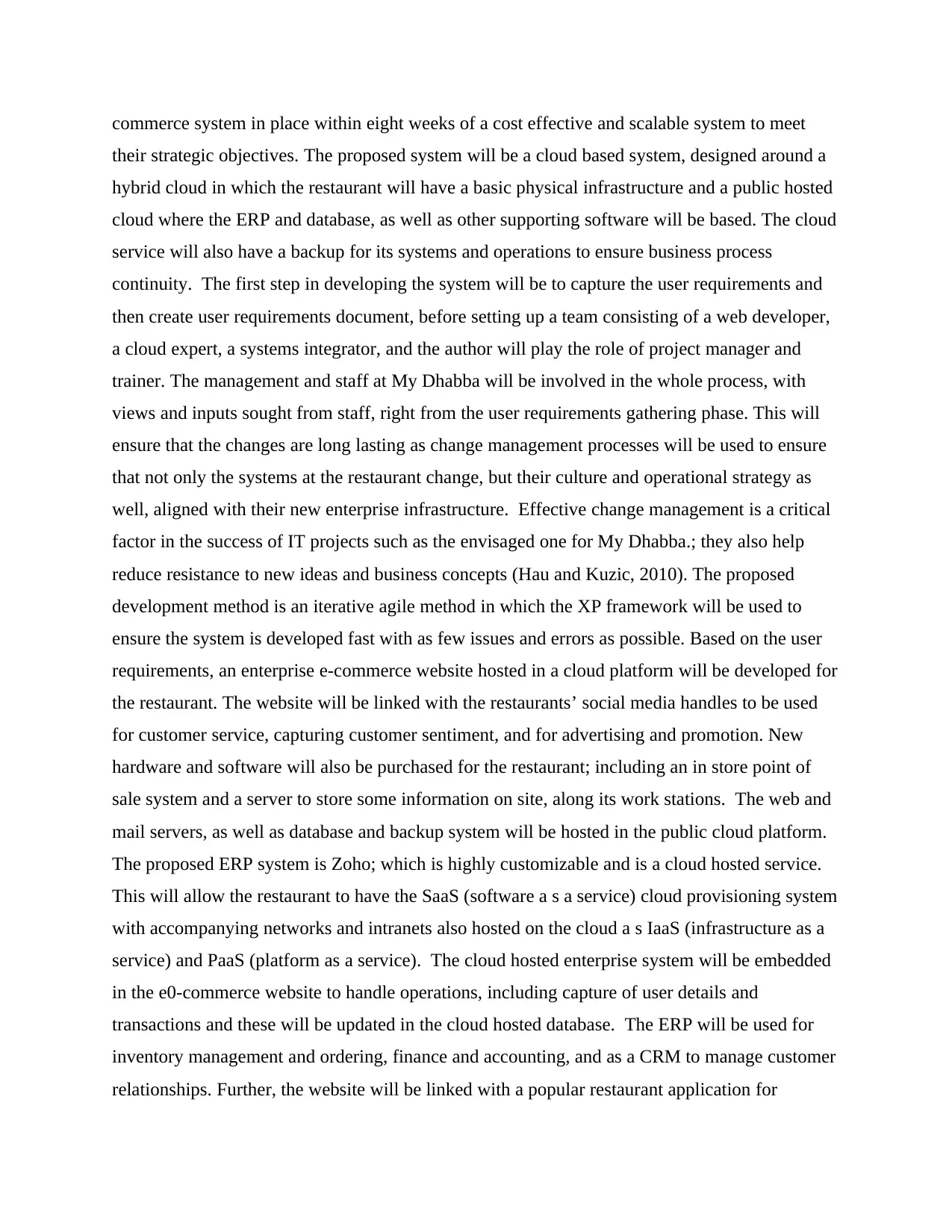
commerce system in place within eight weeks of a cost effective and scalable system to meet
their strategic objectives. The proposed system will be a cloud based system, designed around a
hybrid cloud in which the restaurant will have a basic physical infrastructure and a public hosted
cloud where the ERP and database, as well as other supporting software will be based. The cloud
service will also have a backup for its systems and operations to ensure business process
continuity. The first step in developing the system will be to capture the user requirements and
then create user requirements document, before setting up a team consisting of a web developer,
a cloud expert, a systems integrator, and the author will play the role of project manager and
trainer. The management and staff at My Dhabba will be involved in the whole process, with
views and inputs sought from staff, right from the user requirements gathering phase. This will
ensure that the changes are long lasting as change management processes will be used to ensure
that not only the systems at the restaurant change, but their culture and operational strategy as
well, aligned with their new enterprise infrastructure. Effective change management is a critical
factor in the success of IT projects such as the envisaged one for My Dhabba.; they also help
reduce resistance to new ideas and business concepts (Hau and Kuzic, 2010). The proposed
development method is an iterative agile method in which the XP framework will be used to
ensure the system is developed fast with as few issues and errors as possible. Based on the user
requirements, an enterprise e-commerce website hosted in a cloud platform will be developed for
the restaurant. The website will be linked with the restaurants’ social media handles to be used
for customer service, capturing customer sentiment, and for advertising and promotion. New
hardware and software will also be purchased for the restaurant; including an in store point of
sale system and a server to store some information on site, along its work stations. The web and
mail servers, as well as database and backup system will be hosted in the public cloud platform.
The proposed ERP system is Zoho; which is highly customizable and is a cloud hosted service.
This will allow the restaurant to have the SaaS (software a s a service) cloud provisioning system
with accompanying networks and intranets also hosted on the cloud a s IaaS (infrastructure as a
service) and PaaS (platform as a service). The cloud hosted enterprise system will be embedded
in the e0-commerce website to handle operations, including capture of user details and
transactions and these will be updated in the cloud hosted database. The ERP will be used for
inventory management and ordering, finance and accounting, and as a CRM to manage customer
relationships. Further, the website will be linked with a popular restaurant application for
their strategic objectives. The proposed system will be a cloud based system, designed around a
hybrid cloud in which the restaurant will have a basic physical infrastructure and a public hosted
cloud where the ERP and database, as well as other supporting software will be based. The cloud
service will also have a backup for its systems and operations to ensure business process
continuity. The first step in developing the system will be to capture the user requirements and
then create user requirements document, before setting up a team consisting of a web developer,
a cloud expert, a systems integrator, and the author will play the role of project manager and
trainer. The management and staff at My Dhabba will be involved in the whole process, with
views and inputs sought from staff, right from the user requirements gathering phase. This will
ensure that the changes are long lasting as change management processes will be used to ensure
that not only the systems at the restaurant change, but their culture and operational strategy as
well, aligned with their new enterprise infrastructure. Effective change management is a critical
factor in the success of IT projects such as the envisaged one for My Dhabba.; they also help
reduce resistance to new ideas and business concepts (Hau and Kuzic, 2010). The proposed
development method is an iterative agile method in which the XP framework will be used to
ensure the system is developed fast with as few issues and errors as possible. Based on the user
requirements, an enterprise e-commerce website hosted in a cloud platform will be developed for
the restaurant. The website will be linked with the restaurants’ social media handles to be used
for customer service, capturing customer sentiment, and for advertising and promotion. New
hardware and software will also be purchased for the restaurant; including an in store point of
sale system and a server to store some information on site, along its work stations. The web and
mail servers, as well as database and backup system will be hosted in the public cloud platform.
The proposed ERP system is Zoho; which is highly customizable and is a cloud hosted service.
This will allow the restaurant to have the SaaS (software a s a service) cloud provisioning system
with accompanying networks and intranets also hosted on the cloud a s IaaS (infrastructure as a
service) and PaaS (platform as a service). The cloud hosted enterprise system will be embedded
in the e0-commerce website to handle operations, including capture of user details and
transactions and these will be updated in the cloud hosted database. The ERP will be used for
inventory management and ordering, finance and accounting, and as a CRM to manage customer
relationships. Further, the website will be linked with a popular restaurant application for
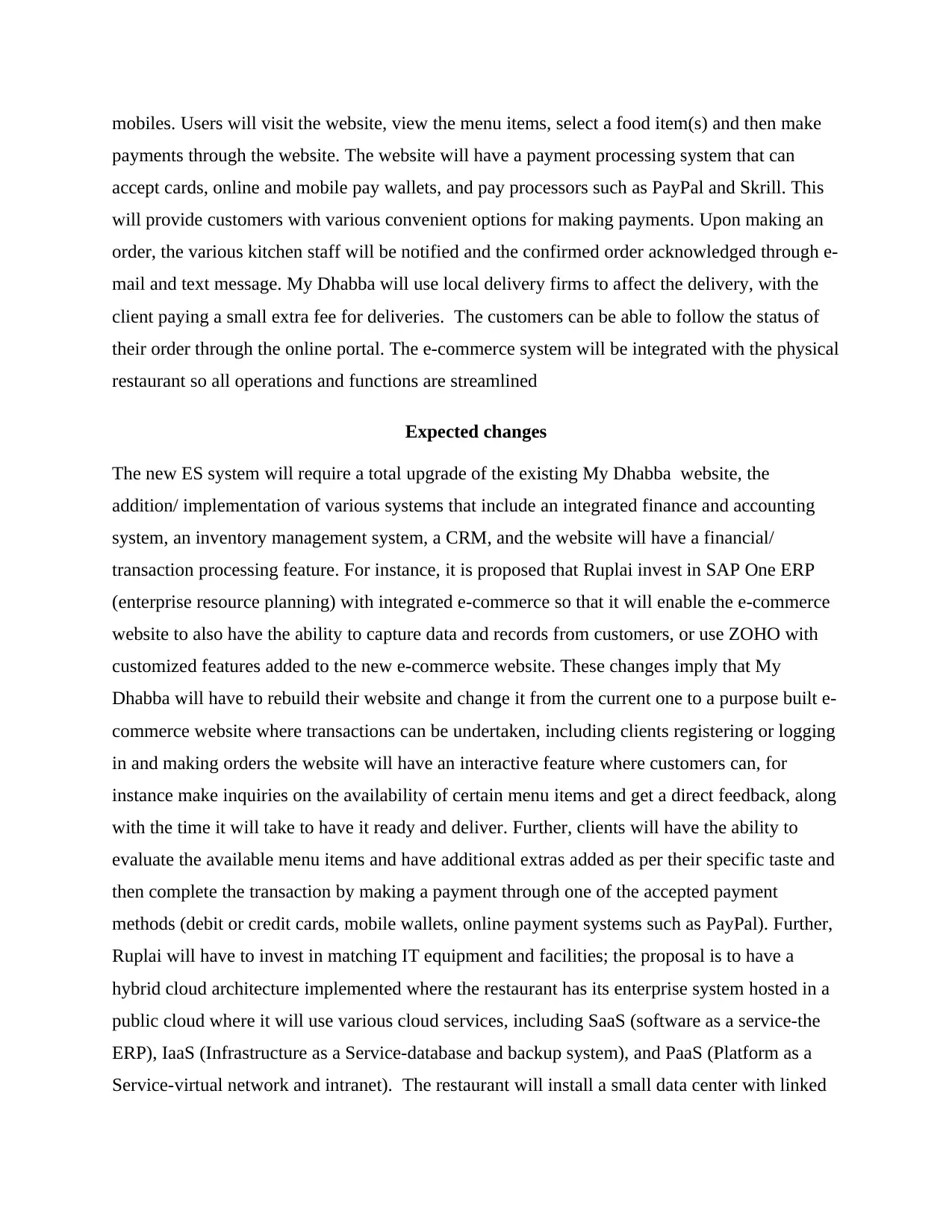
mobiles. Users will visit the website, view the menu items, select a food item(s) and then make
payments through the website. The website will have a payment processing system that can
accept cards, online and mobile pay wallets, and pay processors such as PayPal and Skrill. This
will provide customers with various convenient options for making payments. Upon making an
order, the various kitchen staff will be notified and the confirmed order acknowledged through e-
mail and text message. My Dhabba will use local delivery firms to affect the delivery, with the
client paying a small extra fee for deliveries. The customers can be able to follow the status of
their order through the online portal. The e-commerce system will be integrated with the physical
restaurant so all operations and functions are streamlined
Expected changes
The new ES system will require a total upgrade of the existing My Dhabba website, the
addition/ implementation of various systems that include an integrated finance and accounting
system, an inventory management system, a CRM, and the website will have a financial/
transaction processing feature. For instance, it is proposed that Ruplai invest in SAP One ERP
(enterprise resource planning) with integrated e-commerce so that it will enable the e-commerce
website to also have the ability to capture data and records from customers, or use ZOHO with
customized features added to the new e-commerce website. These changes imply that My
Dhabba will have to rebuild their website and change it from the current one to a purpose built e-
commerce website where transactions can be undertaken, including clients registering or logging
in and making orders the website will have an interactive feature where customers can, for
instance make inquiries on the availability of certain menu items and get a direct feedback, along
with the time it will take to have it ready and deliver. Further, clients will have the ability to
evaluate the available menu items and have additional extras added as per their specific taste and
then complete the transaction by making a payment through one of the accepted payment
methods (debit or credit cards, mobile wallets, online payment systems such as PayPal). Further,
Ruplai will have to invest in matching IT equipment and facilities; the proposal is to have a
hybrid cloud architecture implemented where the restaurant has its enterprise system hosted in a
public cloud where it will use various cloud services, including SaaS (software as a service-the
ERP), IaaS (Infrastructure as a Service-database and backup system), and PaaS (Platform as a
Service-virtual network and intranet). The restaurant will install a small data center with linked
payments through the website. The website will have a payment processing system that can
accept cards, online and mobile pay wallets, and pay processors such as PayPal and Skrill. This
will provide customers with various convenient options for making payments. Upon making an
order, the various kitchen staff will be notified and the confirmed order acknowledged through e-
mail and text message. My Dhabba will use local delivery firms to affect the delivery, with the
client paying a small extra fee for deliveries. The customers can be able to follow the status of
their order through the online portal. The e-commerce system will be integrated with the physical
restaurant so all operations and functions are streamlined
Expected changes
The new ES system will require a total upgrade of the existing My Dhabba website, the
addition/ implementation of various systems that include an integrated finance and accounting
system, an inventory management system, a CRM, and the website will have a financial/
transaction processing feature. For instance, it is proposed that Ruplai invest in SAP One ERP
(enterprise resource planning) with integrated e-commerce so that it will enable the e-commerce
website to also have the ability to capture data and records from customers, or use ZOHO with
customized features added to the new e-commerce website. These changes imply that My
Dhabba will have to rebuild their website and change it from the current one to a purpose built e-
commerce website where transactions can be undertaken, including clients registering or logging
in and making orders the website will have an interactive feature where customers can, for
instance make inquiries on the availability of certain menu items and get a direct feedback, along
with the time it will take to have it ready and deliver. Further, clients will have the ability to
evaluate the available menu items and have additional extras added as per their specific taste and
then complete the transaction by making a payment through one of the accepted payment
methods (debit or credit cards, mobile wallets, online payment systems such as PayPal). Further,
Ruplai will have to invest in matching IT equipment and facilities; the proposal is to have a
hybrid cloud architecture implemented where the restaurant has its enterprise system hosted in a
public cloud where it will use various cloud services, including SaaS (software as a service-the
ERP), IaaS (Infrastructure as a Service-database and backup system), and PaaS (Platform as a
Service-virtual network and intranet). The restaurant will install a small data center with linked
⊘ This is a preview!⊘
Do you want full access?
Subscribe today to unlock all pages.

Trusted by 1+ million students worldwide
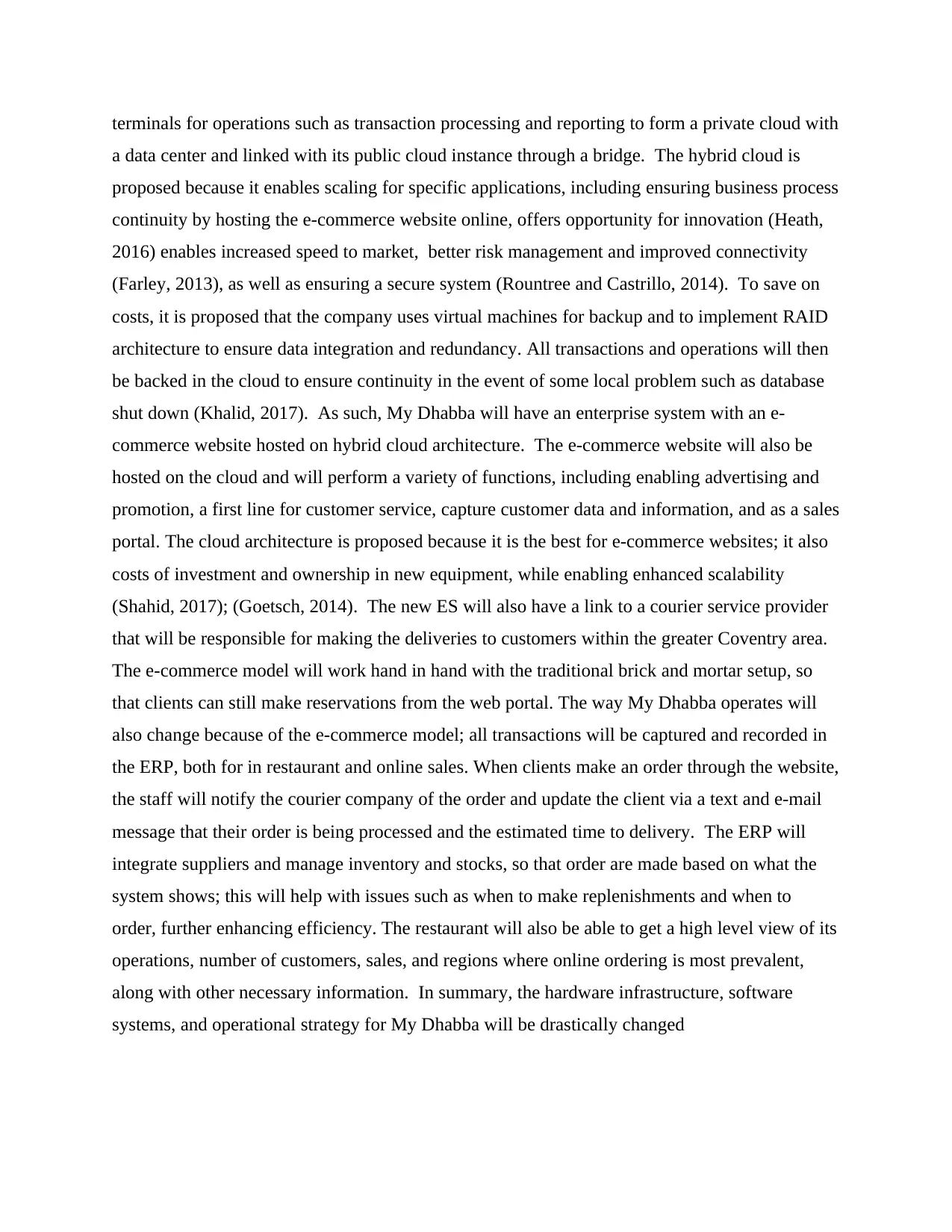
terminals for operations such as transaction processing and reporting to form a private cloud with
a data center and linked with its public cloud instance through a bridge. The hybrid cloud is
proposed because it enables scaling for specific applications, including ensuring business process
continuity by hosting the e-commerce website online, offers opportunity for innovation (Heath,
2016) enables increased speed to market, better risk management and improved connectivity
(Farley, 2013), as well as ensuring a secure system (Rountree and Castrillo, 2014). To save on
costs, it is proposed that the company uses virtual machines for backup and to implement RAID
architecture to ensure data integration and redundancy. All transactions and operations will then
be backed in the cloud to ensure continuity in the event of some local problem such as database
shut down (Khalid, 2017). As such, My Dhabba will have an enterprise system with an e-
commerce website hosted on hybrid cloud architecture. The e-commerce website will also be
hosted on the cloud and will perform a variety of functions, including enabling advertising and
promotion, a first line for customer service, capture customer data and information, and as a sales
portal. The cloud architecture is proposed because it is the best for e-commerce websites; it also
costs of investment and ownership in new equipment, while enabling enhanced scalability
(Shahid, 2017); (Goetsch, 2014). The new ES will also have a link to a courier service provider
that will be responsible for making the deliveries to customers within the greater Coventry area.
The e-commerce model will work hand in hand with the traditional brick and mortar setup, so
that clients can still make reservations from the web portal. The way My Dhabba operates will
also change because of the e-commerce model; all transactions will be captured and recorded in
the ERP, both for in restaurant and online sales. When clients make an order through the website,
the staff will notify the courier company of the order and update the client via a text and e-mail
message that their order is being processed and the estimated time to delivery. The ERP will
integrate suppliers and manage inventory and stocks, so that order are made based on what the
system shows; this will help with issues such as when to make replenishments and when to
order, further enhancing efficiency. The restaurant will also be able to get a high level view of its
operations, number of customers, sales, and regions where online ordering is most prevalent,
along with other necessary information. In summary, the hardware infrastructure, software
systems, and operational strategy for My Dhabba will be drastically changed
a data center and linked with its public cloud instance through a bridge. The hybrid cloud is
proposed because it enables scaling for specific applications, including ensuring business process
continuity by hosting the e-commerce website online, offers opportunity for innovation (Heath,
2016) enables increased speed to market, better risk management and improved connectivity
(Farley, 2013), as well as ensuring a secure system (Rountree and Castrillo, 2014). To save on
costs, it is proposed that the company uses virtual machines for backup and to implement RAID
architecture to ensure data integration and redundancy. All transactions and operations will then
be backed in the cloud to ensure continuity in the event of some local problem such as database
shut down (Khalid, 2017). As such, My Dhabba will have an enterprise system with an e-
commerce website hosted on hybrid cloud architecture. The e-commerce website will also be
hosted on the cloud and will perform a variety of functions, including enabling advertising and
promotion, a first line for customer service, capture customer data and information, and as a sales
portal. The cloud architecture is proposed because it is the best for e-commerce websites; it also
costs of investment and ownership in new equipment, while enabling enhanced scalability
(Shahid, 2017); (Goetsch, 2014). The new ES will also have a link to a courier service provider
that will be responsible for making the deliveries to customers within the greater Coventry area.
The e-commerce model will work hand in hand with the traditional brick and mortar setup, so
that clients can still make reservations from the web portal. The way My Dhabba operates will
also change because of the e-commerce model; all transactions will be captured and recorded in
the ERP, both for in restaurant and online sales. When clients make an order through the website,
the staff will notify the courier company of the order and update the client via a text and e-mail
message that their order is being processed and the estimated time to delivery. The ERP will
integrate suppliers and manage inventory and stocks, so that order are made based on what the
system shows; this will help with issues such as when to make replenishments and when to
order, further enhancing efficiency. The restaurant will also be able to get a high level view of its
operations, number of customers, sales, and regions where online ordering is most prevalent,
along with other necessary information. In summary, the hardware infrastructure, software
systems, and operational strategy for My Dhabba will be drastically changed
Paraphrase This Document
Need a fresh take? Get an instant paraphrase of this document with our AI Paraphraser
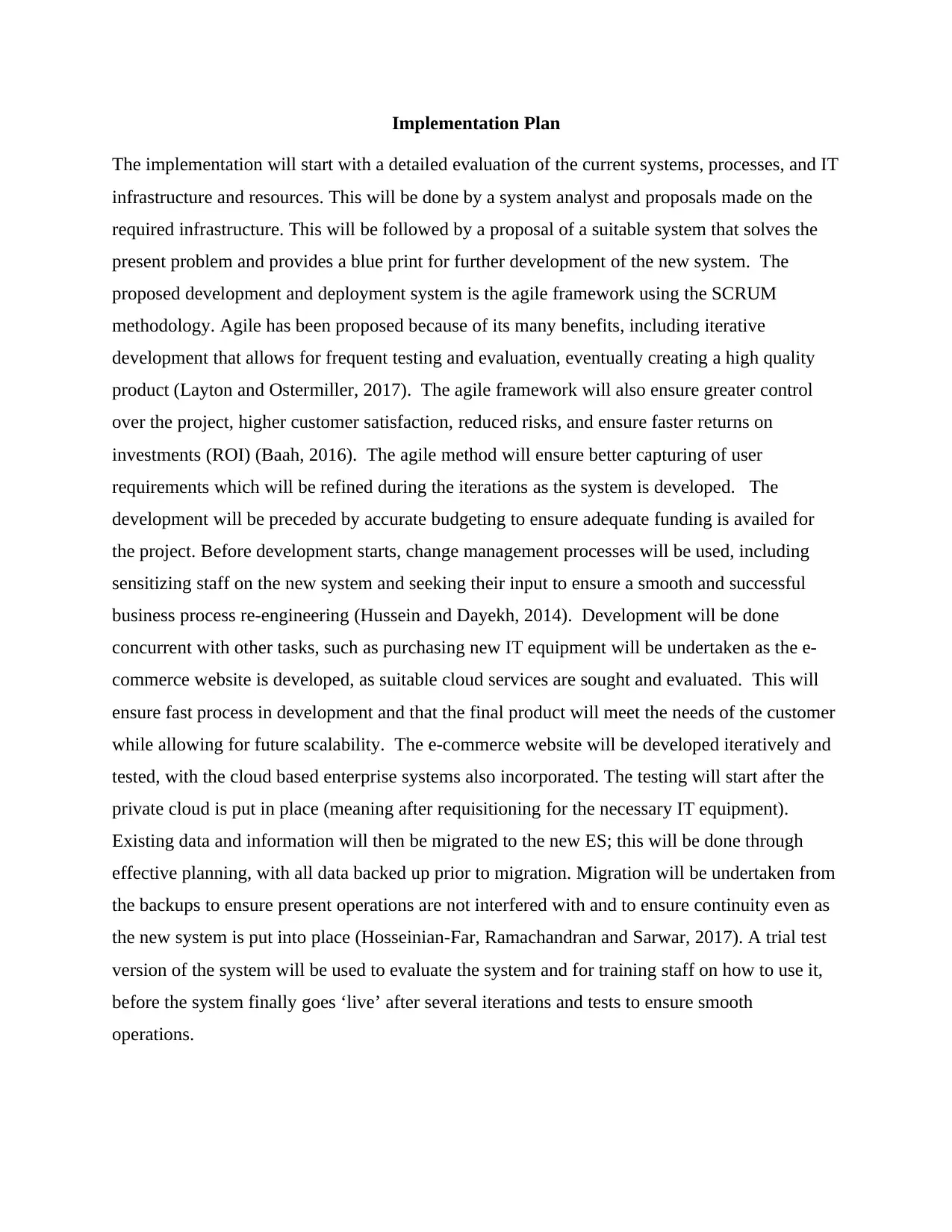
Implementation Plan
The implementation will start with a detailed evaluation of the current systems, processes, and IT
infrastructure and resources. This will be done by a system analyst and proposals made on the
required infrastructure. This will be followed by a proposal of a suitable system that solves the
present problem and provides a blue print for further development of the new system. The
proposed development and deployment system is the agile framework using the SCRUM
methodology. Agile has been proposed because of its many benefits, including iterative
development that allows for frequent testing and evaluation, eventually creating a high quality
product (Layton and Ostermiller, 2017). The agile framework will also ensure greater control
over the project, higher customer satisfaction, reduced risks, and ensure faster returns on
investments (ROI) (Baah, 2016). The agile method will ensure better capturing of user
requirements which will be refined during the iterations as the system is developed. The
development will be preceded by accurate budgeting to ensure adequate funding is availed for
the project. Before development starts, change management processes will be used, including
sensitizing staff on the new system and seeking their input to ensure a smooth and successful
business process re-engineering (Hussein and Dayekh, 2014). Development will be done
concurrent with other tasks, such as purchasing new IT equipment will be undertaken as the e-
commerce website is developed, as suitable cloud services are sought and evaluated. This will
ensure fast process in development and that the final product will meet the needs of the customer
while allowing for future scalability. The e-commerce website will be developed iteratively and
tested, with the cloud based enterprise systems also incorporated. The testing will start after the
private cloud is put in place (meaning after requisitioning for the necessary IT equipment).
Existing data and information will then be migrated to the new ES; this will be done through
effective planning, with all data backed up prior to migration. Migration will be undertaken from
the backups to ensure present operations are not interfered with and to ensure continuity even as
the new system is put into place (Hosseinian-Far, Ramachandran and Sarwar, 2017). A trial test
version of the system will be used to evaluate the system and for training staff on how to use it,
before the system finally goes ‘live’ after several iterations and tests to ensure smooth
operations.
The implementation will start with a detailed evaluation of the current systems, processes, and IT
infrastructure and resources. This will be done by a system analyst and proposals made on the
required infrastructure. This will be followed by a proposal of a suitable system that solves the
present problem and provides a blue print for further development of the new system. The
proposed development and deployment system is the agile framework using the SCRUM
methodology. Agile has been proposed because of its many benefits, including iterative
development that allows for frequent testing and evaluation, eventually creating a high quality
product (Layton and Ostermiller, 2017). The agile framework will also ensure greater control
over the project, higher customer satisfaction, reduced risks, and ensure faster returns on
investments (ROI) (Baah, 2016). The agile method will ensure better capturing of user
requirements which will be refined during the iterations as the system is developed. The
development will be preceded by accurate budgeting to ensure adequate funding is availed for
the project. Before development starts, change management processes will be used, including
sensitizing staff on the new system and seeking their input to ensure a smooth and successful
business process re-engineering (Hussein and Dayekh, 2014). Development will be done
concurrent with other tasks, such as purchasing new IT equipment will be undertaken as the e-
commerce website is developed, as suitable cloud services are sought and evaluated. This will
ensure fast process in development and that the final product will meet the needs of the customer
while allowing for future scalability. The e-commerce website will be developed iteratively and
tested, with the cloud based enterprise systems also incorporated. The testing will start after the
private cloud is put in place (meaning after requisitioning for the necessary IT equipment).
Existing data and information will then be migrated to the new ES; this will be done through
effective planning, with all data backed up prior to migration. Migration will be undertaken from
the backups to ensure present operations are not interfered with and to ensure continuity even as
the new system is put into place (Hosseinian-Far, Ramachandran and Sarwar, 2017). A trial test
version of the system will be used to evaluate the system and for training staff on how to use it,
before the system finally goes ‘live’ after several iterations and tests to ensure smooth
operations.

Benefits of System
The new ES will confer several benefits to My Dhabba restaurant; the benefits include
Efficient operations: The e-commerce based enterprise system will capture data and
automatically store them in a cloud environment. This data and transaction information will
happen automatically, resulting in efficient operations. Speed is also very crucial for an e-
commerce business to keep customers happy. For instance, when a website takes more than three
seconds to load, 40% customers abandon it, according to research (Bhatia, 2018)
Exposure to a wider market: The web presence will mean that the restaurant has robust online
presence; when linked with social media and concepts such as search engine optimization, My
Dhabba will be exposed to a wider market, even for people that have never heard of it before
('Salesforce', 2018).
All round operations: A website stays up and running even when people have closed; as such the
firm will be able to operate round the clock; people can order for food and other items at any
time through the website ('Salesforce', 2018).
Effective decision making based on data: The ES will capture all data and transactions in a
centrally located place, and automatically update any changes. With this information, the
management can better use the data for management accounting and better decision making
based on generated reports; for instance, the system will show what menu items are the most
popular, and so plans can be made to increase their production, as the less popular items are
reduced (Martínez-López, 2013).
Increased revenues and customers: With a wider reach and all round operations, My Dhabba
will benefit from increased sales; the project =ion is that e-commerce sales will overtake in-
restaurant sales as e-commerce is unlimited (Rezaul, 2012)
Better customer service: The website will be interactive, where customers can ask questions and
get instant feedback or detailed feedback through e-mail. With a social media link, the restaurant
will capture customer sentiment and respond to client needs on social media for better service
delivery (Rezaul, 2012)
The new ES will confer several benefits to My Dhabba restaurant; the benefits include
Efficient operations: The e-commerce based enterprise system will capture data and
automatically store them in a cloud environment. This data and transaction information will
happen automatically, resulting in efficient operations. Speed is also very crucial for an e-
commerce business to keep customers happy. For instance, when a website takes more than three
seconds to load, 40% customers abandon it, according to research (Bhatia, 2018)
Exposure to a wider market: The web presence will mean that the restaurant has robust online
presence; when linked with social media and concepts such as search engine optimization, My
Dhabba will be exposed to a wider market, even for people that have never heard of it before
('Salesforce', 2018).
All round operations: A website stays up and running even when people have closed; as such the
firm will be able to operate round the clock; people can order for food and other items at any
time through the website ('Salesforce', 2018).
Effective decision making based on data: The ES will capture all data and transactions in a
centrally located place, and automatically update any changes. With this information, the
management can better use the data for management accounting and better decision making
based on generated reports; for instance, the system will show what menu items are the most
popular, and so plans can be made to increase their production, as the less popular items are
reduced (Martínez-López, 2013).
Increased revenues and customers: With a wider reach and all round operations, My Dhabba
will benefit from increased sales; the project =ion is that e-commerce sales will overtake in-
restaurant sales as e-commerce is unlimited (Rezaul, 2012)
Better customer service: The website will be interactive, where customers can ask questions and
get instant feedback or detailed feedback through e-mail. With a social media link, the restaurant
will capture customer sentiment and respond to client needs on social media for better service
delivery (Rezaul, 2012)
⊘ This is a preview!⊘
Do you want full access?
Subscribe today to unlock all pages.

Trusted by 1+ million students worldwide
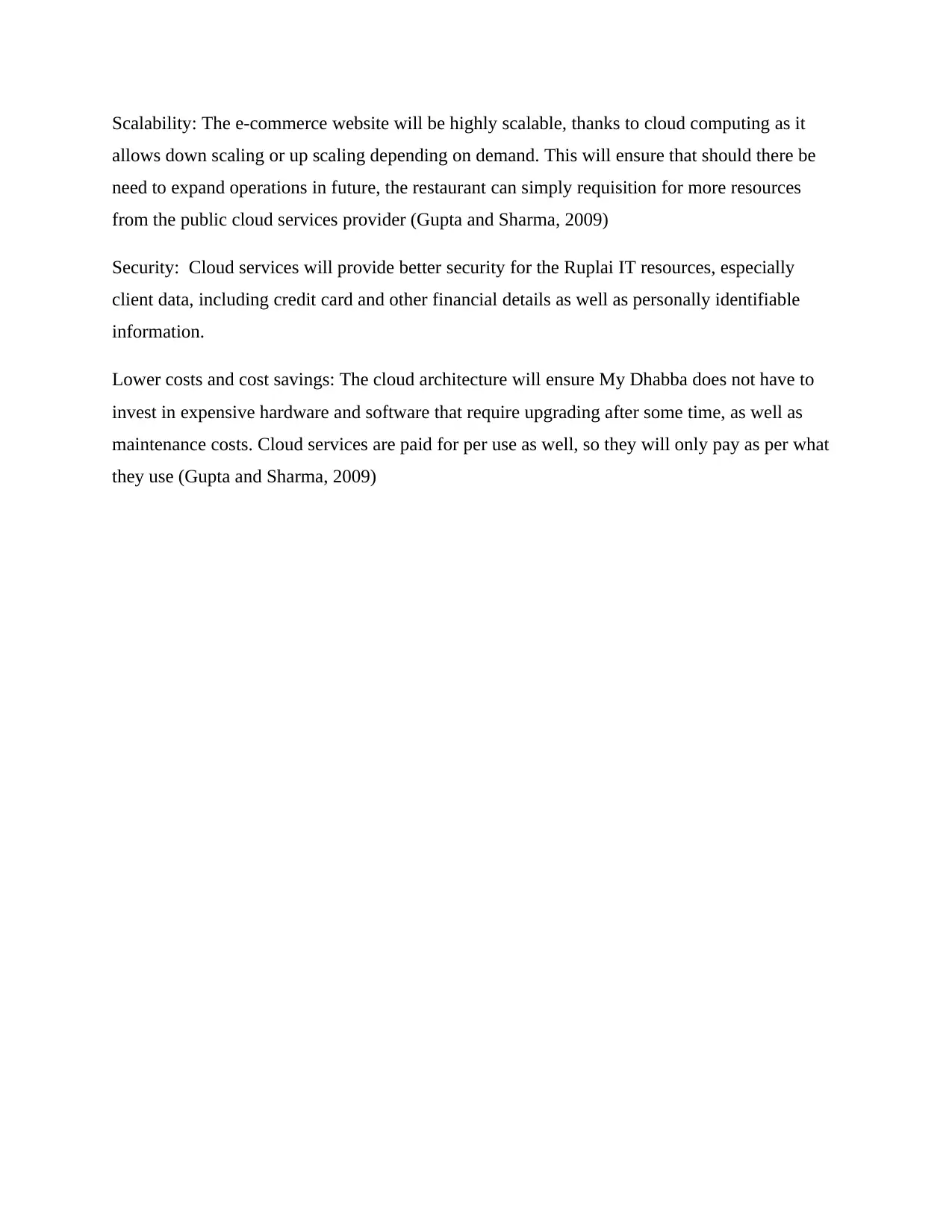
Scalability: The e-commerce website will be highly scalable, thanks to cloud computing as it
allows down scaling or up scaling depending on demand. This will ensure that should there be
need to expand operations in future, the restaurant can simply requisition for more resources
from the public cloud services provider (Gupta and Sharma, 2009)
Security: Cloud services will provide better security for the Ruplai IT resources, especially
client data, including credit card and other financial details as well as personally identifiable
information.
Lower costs and cost savings: The cloud architecture will ensure My Dhabba does not have to
invest in expensive hardware and software that require upgrading after some time, as well as
maintenance costs. Cloud services are paid for per use as well, so they will only pay as per what
they use (Gupta and Sharma, 2009)
allows down scaling or up scaling depending on demand. This will ensure that should there be
need to expand operations in future, the restaurant can simply requisition for more resources
from the public cloud services provider (Gupta and Sharma, 2009)
Security: Cloud services will provide better security for the Ruplai IT resources, especially
client data, including credit card and other financial details as well as personally identifiable
information.
Lower costs and cost savings: The cloud architecture will ensure My Dhabba does not have to
invest in expensive hardware and software that require upgrading after some time, as well as
maintenance costs. Cloud services are paid for per use as well, so they will only pay as per what
they use (Gupta and Sharma, 2009)
Paraphrase This Document
Need a fresh take? Get an instant paraphrase of this document with our AI Paraphraser

References
Adamson, L. (2016). The History of eCommerce. [online] Statementagency.com. Available at:
https://www.statementagency.com/blog/2016/03/the-history-of-ecommerce [Accessed 29 May
2018].
Baah, A. (2016). Agile Software Development. Cork: BookBaby.
Bhatia, G. (2018). 4 Reasons: Why Cloud Computing in E-Commerce is Important?. [online]
Newgenapps.com. Available at: https://www.newgenapps.com/blog/importance-of-cloud-
computing-in-e-commerce [Accessed 26 May 2018].
Gupta, J. and Sharma, S. (2009). Handbook of research on information security and assurance.
Hershey, PA: Information Science Reference.
Hau, T. and Kuzic, J. (2010). Change Management Strategies for the Successful Implementation
of Enterprise Resource Planning Systems. 2010 Second International Conference on Knowledge
and Systems Engineering, 4.
Hussein, B. and Dayekh, A. (2014). Business Process Reengineering (BPR) Key Success
Factors. International Journal of Applied Management Sciences and Engineering, 1(1), pp.58-
66.
Farley, M. (2013). Rethinking enterprise storage. 1st ed. Redmond, Wash.: Microsoft Press.
Goetsch, K. (2014). ECommerce in the cloud. Sebastopol, CA: O'Reilly Media.
Heath, N. (2016). Hybrid cloud: Why hybrid IT may be the better choice | ZDNet. [online]
ZDNet. Available at: https://www.zdnet.com/article/hybrid-cloud-why-hybrid-it-may-be-the-
better-choice/ [Accessed 26 May 2018].
Hosseinian-Far, A., Ramachandran, M. and Sarwar, D. (2017). Strategic engineering for cloud
computing and big data analytics. 1st ed. Cham: Springer International Publishing, p.161.
Khalid, S. (2017). Applied computational intelligence and soft computing in engineering. 1st ed.
Hershey, PA: IGI Global, pp.246-247.
Adamson, L. (2016). The History of eCommerce. [online] Statementagency.com. Available at:
https://www.statementagency.com/blog/2016/03/the-history-of-ecommerce [Accessed 29 May
2018].
Baah, A. (2016). Agile Software Development. Cork: BookBaby.
Bhatia, G. (2018). 4 Reasons: Why Cloud Computing in E-Commerce is Important?. [online]
Newgenapps.com. Available at: https://www.newgenapps.com/blog/importance-of-cloud-
computing-in-e-commerce [Accessed 26 May 2018].
Gupta, J. and Sharma, S. (2009). Handbook of research on information security and assurance.
Hershey, PA: Information Science Reference.
Hau, T. and Kuzic, J. (2010). Change Management Strategies for the Successful Implementation
of Enterprise Resource Planning Systems. 2010 Second International Conference on Knowledge
and Systems Engineering, 4.
Hussein, B. and Dayekh, A. (2014). Business Process Reengineering (BPR) Key Success
Factors. International Journal of Applied Management Sciences and Engineering, 1(1), pp.58-
66.
Farley, M. (2013). Rethinking enterprise storage. 1st ed. Redmond, Wash.: Microsoft Press.
Goetsch, K. (2014). ECommerce in the cloud. Sebastopol, CA: O'Reilly Media.
Heath, N. (2016). Hybrid cloud: Why hybrid IT may be the better choice | ZDNet. [online]
ZDNet. Available at: https://www.zdnet.com/article/hybrid-cloud-why-hybrid-it-may-be-the-
better-choice/ [Accessed 26 May 2018].
Hosseinian-Far, A., Ramachandran, M. and Sarwar, D. (2017). Strategic engineering for cloud
computing and big data analytics. 1st ed. Cham: Springer International Publishing, p.161.
Khalid, S. (2017). Applied computational intelligence and soft computing in engineering. 1st ed.
Hershey, PA: IGI Global, pp.246-247.
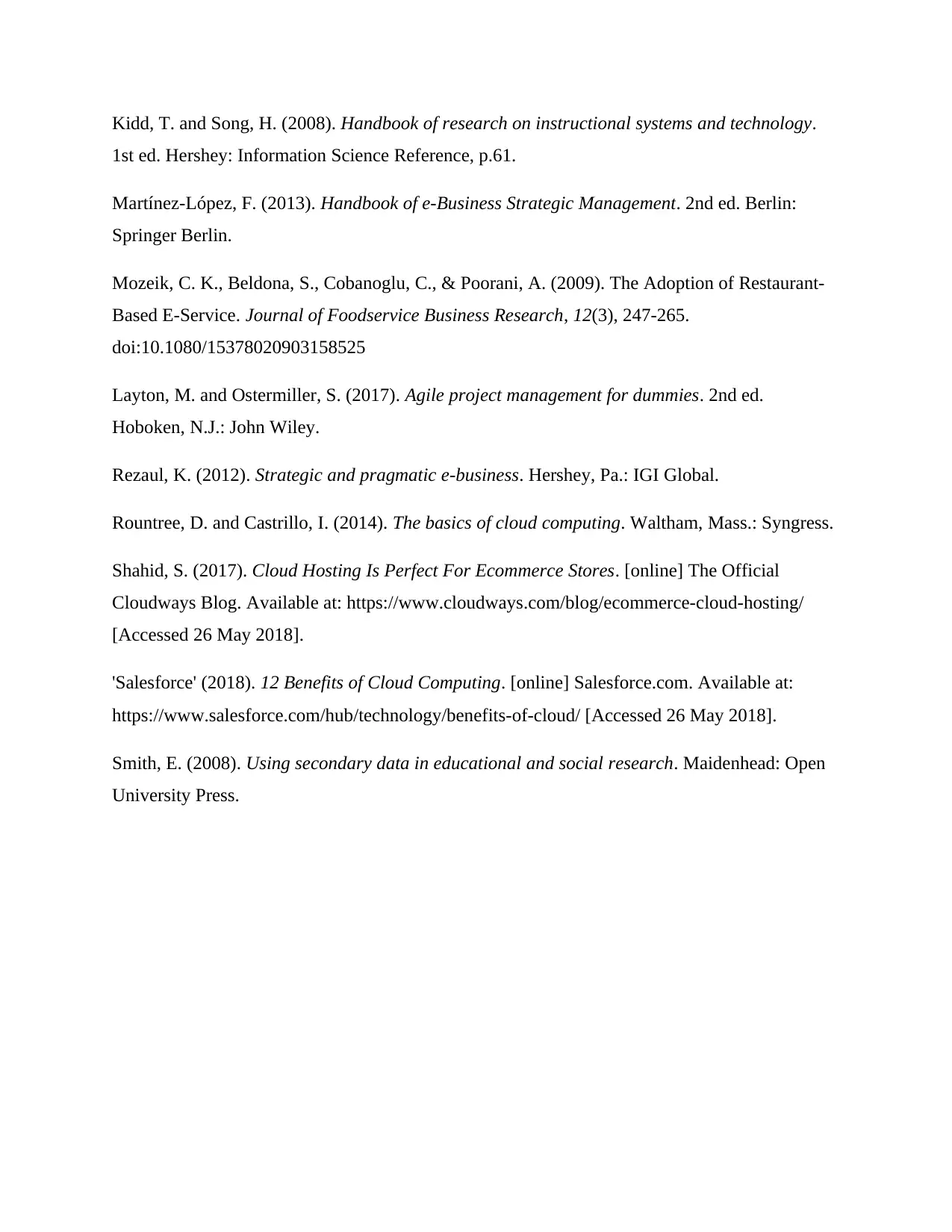
Kidd, T. and Song, H. (2008). Handbook of research on instructional systems and technology.
1st ed. Hershey: Information Science Reference, p.61.
Martínez-López, F. (2013). Handbook of e-Business Strategic Management. 2nd ed. Berlin:
Springer Berlin.
Mozeik, C. K., Beldona, S., Cobanoglu, C., & Poorani, A. (2009). The Adoption of Restaurant-
Based E-Service. Journal of Foodservice Business Research, 12(3), 247-265.
doi:10.1080/15378020903158525
Layton, M. and Ostermiller, S. (2017). Agile project management for dummies. 2nd ed.
Hoboken, N.J.: John Wiley.
Rezaul, K. (2012). Strategic and pragmatic e-business. Hershey, Pa.: IGI Global.
Rountree, D. and Castrillo, I. (2014). The basics of cloud computing. Waltham, Mass.: Syngress.
Shahid, S. (2017). Cloud Hosting Is Perfect For Ecommerce Stores. [online] The Official
Cloudways Blog. Available at: https://www.cloudways.com/blog/ecommerce-cloud-hosting/
[Accessed 26 May 2018].
'Salesforce' (2018). 12 Benefits of Cloud Computing. [online] Salesforce.com. Available at:
https://www.salesforce.com/hub/technology/benefits-of-cloud/ [Accessed 26 May 2018].
Smith, E. (2008). Using secondary data in educational and social research. Maidenhead: Open
University Press.
1st ed. Hershey: Information Science Reference, p.61.
Martínez-López, F. (2013). Handbook of e-Business Strategic Management. 2nd ed. Berlin:
Springer Berlin.
Mozeik, C. K., Beldona, S., Cobanoglu, C., & Poorani, A. (2009). The Adoption of Restaurant-
Based E-Service. Journal of Foodservice Business Research, 12(3), 247-265.
doi:10.1080/15378020903158525
Layton, M. and Ostermiller, S. (2017). Agile project management for dummies. 2nd ed.
Hoboken, N.J.: John Wiley.
Rezaul, K. (2012). Strategic and pragmatic e-business. Hershey, Pa.: IGI Global.
Rountree, D. and Castrillo, I. (2014). The basics of cloud computing. Waltham, Mass.: Syngress.
Shahid, S. (2017). Cloud Hosting Is Perfect For Ecommerce Stores. [online] The Official
Cloudways Blog. Available at: https://www.cloudways.com/blog/ecommerce-cloud-hosting/
[Accessed 26 May 2018].
'Salesforce' (2018). 12 Benefits of Cloud Computing. [online] Salesforce.com. Available at:
https://www.salesforce.com/hub/technology/benefits-of-cloud/ [Accessed 26 May 2018].
Smith, E. (2008). Using secondary data in educational and social research. Maidenhead: Open
University Press.
⊘ This is a preview!⊘
Do you want full access?
Subscribe today to unlock all pages.

Trusted by 1+ million students worldwide
1 out of 12
Related Documents
Your All-in-One AI-Powered Toolkit for Academic Success.
+13062052269
info@desklib.com
Available 24*7 on WhatsApp / Email
![[object Object]](/_next/static/media/star-bottom.7253800d.svg)
Unlock your academic potential
Copyright © 2020–2025 A2Z Services. All Rights Reserved. Developed and managed by ZUCOL.




